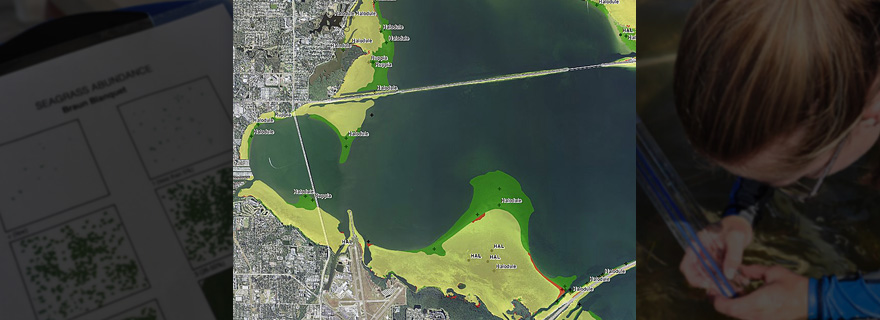Overall, seagrasses cover 41,655 acres of bay bottom, a number that continues to surpass the 38,000-acre goal set by the Tampa Bay Estuary Program (TBEP), and sets a new record for the highest amount of seagrass documented since 1950.
However, scientists caution, the aerial surveys that form the basis of the seagrass estimates were conducted during the winter of 2015-2016 – before the torrential rains of last summer caused emergency sewer discharges into portions of the bay. Sewer overflows associated with heavy rainfall also occurred throughout the bay in summer 2015.
Seagrass gains were documented in every bay segment but Middle Tampa Bay, which lost 42 acres from 2014 to early 2016. Middle Tampa Bay refers to waters south of the Gandy Bridge, including Hillsborough’s South Shore to the Manatee County border, and coastal St. Petersburg to Coquina Key.
The largest gain, 874 acres, was documented in Old Tampa Bay, where historically seagrass recovery and water quality have trailed other bay areas. Old Tampa Bay encompasses the waters from the Gandy Bridge north to Oldsmar and east to Tampa.
Boca Ciega Bay ranked second in acreage gains, with 190 new acres observed.
Hillsborough Bay gained 34 additional acres of seagrass. Hillsborough Bay is traditionally the most heavily impacted part of the bay, encompassing downtown Tampa, the iconic Bayshore Boulevard, and a busy industrial port.
“Overall this is good news,” said TBEP Director Holly Greening. “We will need to carefully watch trends in future years to make sure we maintain progress in bay recovery.”
Seagrasses are important because they are natural “fish factories” that need clean water to flourish. They support a variety of juvenile fish, shrimp, crabs, marine worms and other bay creatures, and remove and store carbon that contributes to greenhouses gases.
The seagrass surveys are coordinated by scientists with the Southwest Florida Water Management District (SWFWMD). Aerial photos are taken every two years in winter, when bay waters are clearest. The digital imagery is plotted, analyzed and ground-truthed to verify accuracy. SWFWMD has used this comprehensive process to track trends in seagrass extent in Florida estuaries since 1988.
The seagrass assessment is bolstered by results from monthly water quality sampling. All major bay segments met water quality targets in 2016, although the area north of the Gandy Bridge, known as Old Tampa Bay, continues to struggle with high levels of algae that lowered its overall ranking.
Water quality testing is conducted monthly by the Environment Protection Commission of Hillsborough County (EPC) at 45 fixed sampling stations in the four major bay segments – Hillsborough Bay, Old Tampa Bay, Middle Tampa Bay and Lower Tampa Bay. The sampling measures both the amount of chlorophyll (abundance of algae) in the water, and the amount of visible sunlight penetrating the water column.
TBEP annually produces a “report card” comparing the water sampling with established targets for each bay segment. “Green” means a bay segment is meeting all water quality targets averaged over a 12-month period, while “red” means it is not. “Yellow” indicates that an area failed to meet either chlorophyll or water clarity targets in a given year.
The water quality sampling may not detect short-term or locally specific water quality impacts.
The combination of water quality and seagrass information gives bay managers a valuable set of tools to assess the bay’s overall health, tracking long-term progress in restoring the bay and serving as an early-warning system for potential problems. For example, the nuisance algae Pyrodinium bahamense was again documented in Old Tampa Bay during summer 2016, contributing to persistent water quality issues there.
Widespread flooding and emergency discharges of treated and untreated wastewater also occurred during August and September 2016 – but did not affect overall water quality results for Middle Tampa Bay, where most of the discharges occurred. Scientists suggest that the sheer volume of rainfall may have helped dilute or flush nutrient pollution from the bay.
[su_divider]
